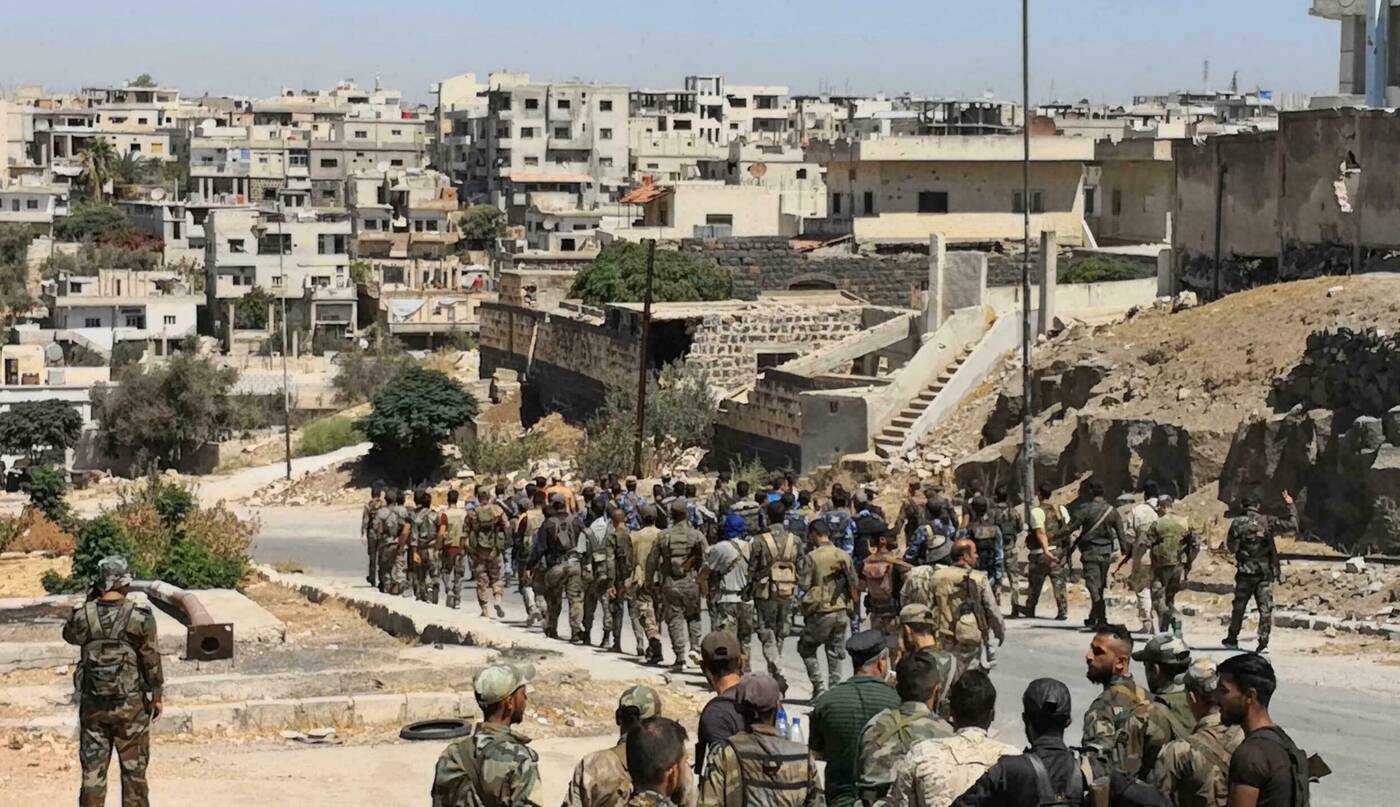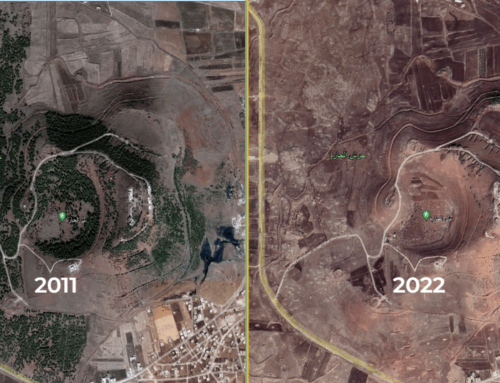Months into new Daraa settlement, assassinations continue unabated
Amid continuing assassinations in Daraa province and the convergence of some parties’ interests against others, the pattern of assassinations remains the same, supporting the idea that the perpetrators, too, remain the same.
29 December 2021
PARIS — In the northern Daraa countryside city of Inkhil, Mamoun al-Jabawi, the deputy head of the Damascus-affiliated city council, was fired upon in broad daylight by unidentified attackers in front of the council’s courtyard on December 9, killing him instantly.
The assassination came three months into the new Russian-sponsored Daraa settlement agreement, signed this past September between negotiating committees and government forces in the southern Syrian province. Al-Jabawi, a former colonel, is one of 95 people killed in 138 assassination attempts between the signing of the new settlement and December 26, the date this data was obtained by Syria Direct from the Daraa Martyrs Documentation Office, a local human rights organization.
While assassinations have been ongoing in southern Syria since the first Russian-sponsored settlement was signed between the regime and opposition factions in July 2018, their recent escalation and spread to all of Daraa following the signing of the second settlement points to the failure of the latest deal to reduce targeted killings and shows that little has changed in the province.
No fundamental difference between the settlements
In mid-August, the Russian delegation presented the negotiating committee in Daraa city with a roadmap that included the formation of a coordination center tasked with organizing negotiations between the three parties—the Russians, the regime, and the Daraa committee—in order to reach a solution in Daraa al-Balad, as well as to oversee the Russian roadmap and monitor its implementation.
On September 6, the regime Security Committee in Daraa finished implementing the terms of the settlement in Daraa al-Balad in the presence of a Russian military and security delegation. The settlement was to be spread to all the cities and towns of the Houran region that were controlled by opposition factions prior to summer 2018, as well as the central Daraa countryside city of Izraa, which was not opposition-controlled.
The terms of the new Russian roadmap were not fundamentally different from the 2018 settlement, except in relation to turning over individual weapons belonging to former opposition fighters known as the settlement forces, a source close to the Houran Central Committee told Syria Direct. Formed in February 2020, the Committee encompasses all negotiating committees in Daraa. In the 2018 settlement, the regime allowed settlement forces to keep their weapons.
The latest settlement is also distinguished from its predecessor as it “forbids the arrest of any individual unless a request for his arrest is issued by the judiciary or a personal claim,” a source from the Daraa city negotiating committee told Syria Direct. “This settlement is inclusive and recognized by all regime security branches, meaning there will not be separate [arrest] requests for each branch,” unlike the 2018 settlement, which “had some problems like the names of wanted individuals who took part in the settlements not being wiped from all security branches.”
But the source close to the Houran Central Committee questioned the new settlement’s success: “There is no trust in the regime. It could betray us whenever it wants, as it did many times before.”
‘Extortion’
Several sources in the province accused the regime’s Daraa Security Committee, represented by its former head Hussam Louka, of extorting Houran tribes and negotiating committees in order to complete the second settlement.
A source formerly with the Southern Front, the umbrella that encompassed opposition factions in southern Syria until the summer 2018 settlement, told Syria Direct that Louka “extorted payments, threatening to storm the area.” The source, who asked not to be identified, alleged that “some negotiating committees and tribes paid thousands of dollars to Hussam Louka and the Security Committee to complete the new settlement that was imposed upon them.”
Ayman Abo Noqta, the spokesperson for the Houran Free League, an opposition media association monitoring southern Syrian news, said “the negotiating committee in the city of Nawa paid SP 100 million [$27,933 according to the black market exchange rate], equivalent to the price of 50 individual weapons, in addition to turning over 50 weapons.” He told Syria Direct that “the Security Committee required the negotiating committee to turn over 100 weapons to finalize the settlement.”
But both the source close to the Houran Central Committee and a negotiator on the Daraa city committee denied that Daraa’s tribes and negotiating committees paid any money to the Security Committee and Major General Louka. They explained that the funds collected were to buy light weapons to supplement the number of weapons required by the Security Committee.
According to the source close to the Houran Central Committee, “most cities and towns did not give the full number of weapons requested by the regime, so weapons were bought from traders with the goal of turning them over to the Security Committee to stop the threats of invasion.” He noted that “the condition of handing over weapons has been used by the regime for months. It requires weapons to be turned over in exchange for the release of detainees and kidnapped people, for settlements, or even for services.”
The Daraa Security Committee required the Houran tribes and negotiating committees to hand over a specific number of light weapons to each city and town as a condition for the new settlement process. In the city of Tafas, the regime required the negotiating committee to hand over 100 rifles, a mortar launcher, and a number of locally-made missiles. The southwest Daraa town of Tel Shehab and the west Daraa town of Saham were required to turn in 10 Kalashnikov rifles. Yadoudah and Tseel, west of Daraa, were required to hand over 11 rifles each, and “these amounts have been turned in,” according to the source close to the Houran Central Committee.
‘They only live on chaos’
Syria Direct’s graph of assassinations and attempted assassinations in Daraa province since the beginning of the year shows a decrease in killings and the death toll over the period of military escalation in Daraa al-Balad and during the new settlement operations. However, assassinations soon escalated, reaching the same rate as before the settlement.
Although the regime’s goal from the settlement is to limit the proliferation of weapons in the area, renewed assassinations highlight that “insecurity and the proliferation of weapons continues, and that the regime, one way or another, sponsors this chaos,” Omar al-Hariri, a member of the Daraa Martyrs Documentation Office told Syria Direct. “The majority of assassinations target former opposition fighters,” he said, but also “civilians and members of local councils.”
The continuation and escalation of assassinations despite the new settlement is to be expected, according to the negotiator from the Daraa committee, “due to the large number of players benefiting from them, such as the regime, Lebanese Hezbollah, Iran and its militias, drug dealers, and ISIS fighters who got out of regime prisons, in addition to revenge killings.” Therefore, “the perpetrator of an assassination can only be known by knowing the victim’s background.”
The conflict between the Syrian security services—whose loyalty has been split between Iran and Russia since the 2018 southern settlement—also contributes to the continued assassinations. It has translated into killings between intelligence agencies, direct confrontations, and one agency inciting notables and residents against another.
In Inkhil, north of Daraa, “military security is trying to expel state security from the city,” a former military commander there told Syria Direct. “The matter has developed to the point that military security asked the city’s notables to stir people up to go out in demonstrations against state security,” promising to “enter the city and improve the state of services and security, including expelling Iranian cells.”
The Daraa committee negotiator agreed with the former Southern Front military commander’s assessment that “the regime bears responsibility for the security chaos and assassinations, whether because of its involvement in them or because it is responsible for controlling security in the area.” However, he emphasized that “there are parties that do not want pacification in the south, because they only live on chaos, such as Iran, Hezbollah, and ISIS members.”
The Iranian role
Three sources in Daraa who spoke with Syria Direct accused Iran and the militias associated with it of being behind assassinations in the province. This accusation does not negate the regime’s responsibility for insecurity, especially since “the Iranian presence represented by Air Force Intelligence, the Raids Branch 215 and the 4th Division Office is behind most assassinations in the western Daraa countryside,” according to the source close to the Houran Central Committee.
That is consistent with the statistics of the Daraa Martyrs Documentation Office, according to al-Hariri. “We noticed that the western Daraa countryside saw the largest portion of assassinations after the new settlement,” he said, while “assassinations have very clearly decreased in Daraa al-Balad compared with the months preceding the new settlement.”
In November, the Daraa Martyrs Documentation Office documented 48 assassinations and attempted assassinations, 32 of which occurred in the western Daraa countryside. Some 16 operations took place in the eastern Daraa countryside, while none were documented in Daraa city.
The decline in assassinations in Daraa al-Balad goes back to “the reduced presence of Iranian militias and the regime in it, under the latest settlement,” according to the negotiator on the Daraa committee. The regime presence there is currently limited to “some security points that do not interfere with anybody, as well as two military checkpoints at the southern and eastern entrances to Daraa city. They do not stop anybody because their relationship is with the negotiating committee.”
In contrast, the continued assassinations in the western Daraa countryside could reflect “ongoing attempts by the Iranian current to penetrate west of Daraa and eliminate all figures opposed to the Iranian presence in the area,” according to the former Southern Front military commander. He pointed out that Iran sticks to the western countryside “due to its geographical importance,” given its proximity to the occupied Golan Heights and the Jordanian border.
Iran’s interests coincide with those of the regime, which “considers the latest settlements insufficient, and seeks to extend its security grip over all the cities and towns of the Houran,” according to the same military commander. Accordingly, “Iran takes advantage of the regime’s orientation in order to achieve its aim of turning the area into a southern suburb,” similar to the Dahieh suburb of Beirut in Lebanon, which is under Hezbollah’s influence.
Amid continuing assassinations in Daraa province and the convergence of some parties’ interests against others, the pattern of assassinations remains the same, supporting the idea that the perpetrators, too, remain the same. “There is no cause for optimism that the assassinations will end soon,” said al-Hariri. Nor, seemingly, are there any intentions to stop them.
This report was originally published in Arabic and translated into English by Mateo Nelson.







